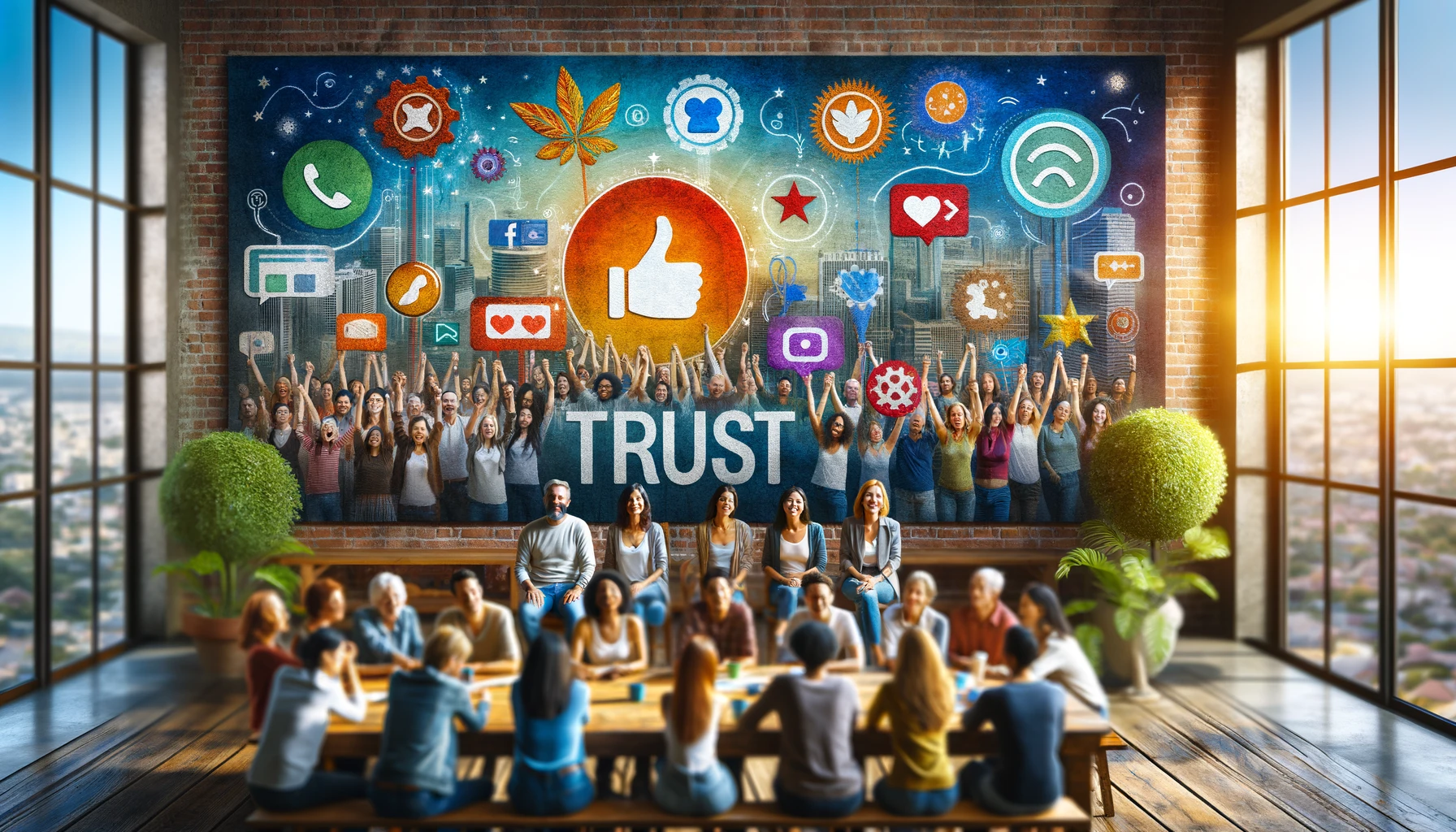Discover how authentic marketing can enhance your brand with effective UGC strategies. Learn how user-generated content builds trust, boosts engagement, and fosters brand loyalty.
Key Takeaways:
- Connect with Customers: User-generated content (UGC) helps brands form genuine connections with their audience.
- Build Trust: UGC showcases real customer experiences, building trust and credibility for your brand.
- Boost Engagement: Encouraging UGC fosters community involvement and increases audience engagement.
- Enhance Brand Loyalty: Involving customers in content creation leads to stronger brand loyalty.
- Drive Marketing Impact: Effective UGC strategies amplify your marketing impact through authentic, relatable content.
Table of Contents
Introduction
In a world where consumers are bombarded with advertisements and brand messages, how can small businesses stand out and connect authentically with their audience? The answer lies in leveraging the voices of those who matter most—your customers. User-generated content (UGC) has become a powerful marketing tool, enabling brands to build trust, foster engagement, and create a genuine connection with their audience.
Consider this: people are twice as likely to view user-generated content as authentic compared to content created by brands. With this in mind, UGC presents an incredible opportunity for small businesses to showcase their products or services through the eyes of their customers. This approach not only provides social proof but also creates a sense of community around the brand.
In this blog, we’ll explore the power of user-generated content marketing and reveal practical strategies to harness its potential for authentic marketing. From creating UGC campaigns to overcoming challenges, you’ll discover actionable insights to elevate your brand through the voices of your customers.
The Power of User-Generated Content Marketing
What is User-Generated Content?
User-generated content (UGC) is any form of content—text, images, videos, reviews—created by customers rather than by the brand itself. It encompasses a wide range of media, including social media posts, blogs, testimonials, and even creative works inspired by the brand. UGC provides an authentic perspective on products or services, offering insights straight from the customers who use them.
UGC is powerful because it represents genuine customer experiences and opinions. It resonates with other potential customers because it comes from a relatable, unbiased source. In a digital world filled with marketing noise, UGC stands out as a breath of fresh air—real stories from real people.
Why UGC Resonates with Audiences
UGC resonates with audiences because it’s relatable, authentic, and trustworthy. People tend to trust recommendations from other consumers over traditional advertising. When customers share their experiences with a brand, it creates a sense of community and belonging, making others more likely to engage with the brand as well.
- Relatability: UGC often reflects the real-life experiences and challenges of customers, making it more relatable than polished brand messages.
- Authenticity: Because UGC is created by real people without the influence of a brand, it feels more authentic and genuine.
- Trust: Potential customers trust UGC because it provides social proof, showing that others have had positive experiences with the brand.
The Impact of UGC on Brand Trust

One of the key benefits of UGC is its ability to build trust. When customers see other people sharing positive experiences with a brand, it validates the brand’s credibility. This trust extends to potential customers, who are more likely to choose a brand that they see positively represented by their peers.
UGC also fosters transparency, which is crucial for building customer trust. By showcasing real customer feedback, brands demonstrate that they value customer opinions and are willing to share them publicly, even if they’re not always perfect.
The Role of UGC in Community Building
UGC plays a significant role in building a community around a brand. When customers share their experiences or interact with each other on social media, it creates a sense of camaraderie and shared identity. This community aspect strengthens brand loyalty and encourages customers to become advocates for the brand.
- Customer Interaction: UGC encourages interaction among customers, creating a lively and engaged community.
- Brand Advocacy: Satisfied customers who contribute UGC often become brand advocates, promoting the brand to their networks.
- Shared Identity: UGC fosters a sense of belonging, where customers feel connected to the brand and to each other.
UGC Strategies for Authentic Marketing
Creating a UGC Campaign
Creating a successful user-generated content campaign involves encouraging your customers to share their experiences with your brand. This can be done through contests, branded hashtags, or even simple calls to action. The key is to make participation easy and rewarding.
- Set Clear Goals: Determine what you want to achieve with the UGC campaign. This could be increasing brand awareness, gathering customer feedback, or showcasing product use cases.
- Choose a Platform: Decide where your campaign will live. Popular options include social media platforms like Instagram, Facebook, or Twitter.
- Create a Call to Action: Encourage customers to share their experiences with a clear and compelling call to action, such as “Share your favorite product moment with #MyBrandExperience.”
- Offer Incentives: Incentives like discounts, prizes, or features on the brand’s page can motivate customers to participate.
- Promote the Campaign: Use your brand’s channels to promote the UGC campaign, and consider using paid advertising to reach a wider audience.
Leveraging Social Media for UGC
Social media is a natural fit for UGC because it’s where customers already share their thoughts, photos, and videos. Leveraging social media for UGC can enhance brand visibility and engagement.
- Branded Hashtags: Create a unique, branded hashtag for customers to use when sharing content. This helps track UGC and builds brand recognition.
- Reposting UGC: Show appreciation for customers by reposting their content on your brand’s social media pages. This creates a positive feedback loop and encourages others to participate.
- Creating Challenges: Social media challenges are a fun way to engage customers and generate UGC. Examples include photo challenges, video challenges, or themed content weeks.
Encouraging Customer Reviews
Customer reviews are a powerful form of UGC that directly influence purchasing decisions. Encouraging satisfied customers to leave reviews can boost your brand’s credibility and attract new customers.
- Make Reviewing Easy: Provide clear instructions and direct links to review sites or platforms, making it easy for customers to leave a review.
- Ask for Reviews: Simply asking satisfied customers for reviews can be highly effective. Send follow-up emails or include requests for reviews in product packaging.
- Offer Incentives: Offer small incentives like discounts or entry into a giveaway for customers who leave reviews. This can motivate customers to share their positive experiences.
UGC and Influencer Marketing
UGC and influencer marketing go hand in hand. Influencers create content that resonates with their followers, and their endorsements serve as powerful UGC for brands.
- Identify Relevant Influencers: Find influencers whose audience aligns with your brand’s target market. Their followers are more likely to trust their recommendations.
- Collaborate on Content: Work with influencers to create content that showcases your brand authentically. This could include product reviews, tutorials, or lifestyle content.
- Promote Influencer Content: Amplify the impact of influencer UGC by sharing it on your brand’s channels and encouraging your audience to engage with it.
Overcoming UGC Marketing Challenges
Monitoring and Moderating UGC
One of the key challenges of user-generated content marketing is monitoring and moderating the influx of content. While UGC can be valuable, it’s essential to ensure that it aligns with your brand’s values and messaging.
- Set Clear Guidelines: Provide customers with clear guidelines for the type of content you’re seeking. This helps prevent inappropriate or off-brand submissions.
- Use Moderation Tools: Utilize moderation tools available on social media platforms or third-party services to filter and review content before it goes live.
- Assign a UGC Moderator: Designate a team member or a group to oversee UGC submissions. Their role is to monitor, approve, and engage with user-generated content.
Addressing Legal and Copyright Issues

Legal and copyright issues can arise when using user-generated content. It’s important to navigate these issues carefully to avoid disputes or damage to your brand’s reputation.
- Obtain Permission: Before using UGC, always obtain permission from the original creator. This can be done through direct communication or by including permission terms in your UGC campaign guidelines.
- Credit the Creator: Always credit the original creator when sharing or using UGC. This shows respect for their work and builds trust with your audience.
- Be Aware of Copyright: Understand that just because content is shared publicly doesn’t mean it’s free to use. Be mindful of copyrighted material` and seek legal advice if unsure.
Maintaining Brand Consistency
Maintaining brand consistency is crucial when using UGC, as varying content styles and messages can dilute your brand’s identity.
- Curate Selectively: Carefully select UGC that aligns with your brand’s image and values. Not all submissions will fit your brand, and that’s okay.
- Create Templates: Provide customers with templates or guidelines for creating UGC that aligns with your brand’s style. This could include branded frames, filters, or suggested messaging.
- Engage with UGC Creators: Build relationships with UGC creators who align with your brand. Their ongoing contributions can help maintain consistency and strengthen brand identity.
Conclusion
User-generated content marketing offers small businesses a unique opportunity to connect with their audience in a meaningful and authentic way. By harnessing the power of customer-created content, brands can build trust, foster engagement, and create a sense of community around their products or services.
Through the strategies outlined, it’s clear that UGC has the potential to transform your brand’s marketing efforts. Whether you’re creating a UGC campaign, leveraging social media, encouraging customer reviews, or partnering with influencers, the key lies in empowering your customers to share their stories.
However, it’s essential to navigate the challenges associated with UGC marketing thoughtfully. By setting clear guidelines, moderating content, addressing legal issues, and maintaining brand consistency, small businesses can leverage UGC effectively while staying true to their brand’s identity.
In today’s digital landscape, authenticity is more valuable than ever. UGC allows businesses to showcase their brand through the eyes of their customers, creating a genuine and relatable connection with their audience. By implementing the UGC strategies and overcoming the challenges discussed, small businesses can achieve authentic marketing that resonates with their audience and drives brand loyalty.
Now, it’s time to put these insights into action. Start by identifying the UGC strategies that align with your brand and experiment with different approaches. Engage with your customers, celebrate their stories, and watch as they become powerful advocates for your brand.
Call to Action
We’d love to hear from you! Have you implemented any UGC strategies in your business? Share your tips, experiences, or favorite UGC campaigns in the comments below. For more insights on authentic marketing and brand engagement, check out our other resources and start exploring the world of user-generated content today.
FAQs
What is user-generated content marketing?
User-generated content marketing is a strategy that involves leveraging content created by customers to promote a brand or product. This can include reviews, social media posts, videos, and more. It’s a way for brands to showcase real customer experiences and build trust with their audience.
How does UGC improve brand authenticity?
UGC improves brand authenticity by providing genuine customer perspectives. When potential customers see real people using and enjoying a product, it feels more relatable and trustworthy than traditional advertising. This authenticity helps build a stronger connection with the audience.
What are some examples of successful UGC campaigns?
Successful UGC campaigns include Coca-Cola’s “Share a Coke” campaign, which encouraged customers to share photos with personalized Coke bottles, and Starbucks’ “White Cup Contest,” where customers designed artwork on Starbucks cups. These campaigns engaged customers and showcased their creativity.
How can brands encourage user-generated content creation?
Brands can encourage UGC creation by running contests, creating branded hashtags, and simply asking customers to share their experiences. Offering incentives, like discounts or features on the brand’s page, can also motivate customers to participate.
What are the potential risks of UGC marketing?
The potential risks of UGC marketing include inappropriate or off-brand content, copyright issues, and negative feedback. Brands can mitigate these risks by setting clear guidelines, using moderation tools, and obtaining permission from UGC creators before using their content.
